|
|
 Big Game Hunters, by Waldo Bien (1989 Congo) Big Game Hunters, by Waldo Bien (1989 Congo)
The clay wall I was leaning on, seemed to want to absorb me in a cold and clammy embrace. From the overlapping, corrugated roof a glittering, pearl curtain was running noisily down to the ground where it turned into a boiling river. My soaking shoes were a strange obstacle in the long row of bare feet of those who, like myself, gathered here to find coverage against tropical rain. The Pygmy boy, standing in silent adoration beside me, had his body wrapped into a ragged muddy raincoat. His delicate hands held a fresh green bamboo staff, a little taller than himself. His head carefully covered with a hat that was folded from banana leaf, a Trojan helmet , giving him a regal appearance. With a gesture he demands the wet, pitiful smouldering cigarette that hung from my lips. After I had given it to him, he did several long drags, then left. He came back with an elder man who turned out to be his father, the chief of this small clan. I gave him the cigarette he asked for. He asked me to follow him.
Inside hung the smell of banana beer. Some danced in half drunken trance. Men, women and children were hanging around, ignored my presence, and seemed to look through me as if I was transparent. I was guided to a bench in a corner, an arm’s length away from a small fire.
The chief and his son sat next to me. There were no questions to answer. Some small but lively woman sat nearby with children wrapped in some cloths. Two children were fed from her long stretched breasts. This milk must taste concentrated, almost condensed, I thought. Soft rocking of children was accompanied by polyphonic songs, archaic roots. The sound they produced and the way they moved: some of the men and women danced in a strange energetic choreography and jumping rhythm. The closest I could get were Martin Schönenborn’s drawings, his neuron physiological recordings. It all had the volume of a jungle concert hall. Some singers produced several voices on different tone levels and in such speed, that it seemed that several spirits of the forest shared one voice. A bouquet of all beings that had lived, live and will once live in the jungle forest.
The branches that I’d added onto the fire were carefully removed again by the chief’s son and laid aside.
I don’t remember how long I been sitting there. Time was not present, not relevant in our sense. Time was life itself, a stand -still on the move. Not more than a bottle that passes by or a swinging door. Strange, I didn’t feel at all an intruder ,or, observer. I had gone out of myself; turned ‘wild’ I sat in the corner of the hut and noticed something changing inside me. My bloodstream was like a slow river as if my juice had turned thicker. Those unusual sounds reminded me of birth. The first unfiltered sounds we pick up are exponents of a still universal language, cosmic sound. Still without image or meaning attached. I knew nothing about this language. But I could feel the forest spirits in their singing.
There exists what one could call a pré language;
I imagined myself sitting in a café in Paris and listening to a conversation that found place at the table behind me: “ Muhavura gahinga sabinyo bisoke karasimbi niragongo, osorno tijijama. Koliwauwau matavana ma oena loa kilimansjaro krakatau.” I heard someone say. By the way, all ‘words’ are names of volcanoes, spread out over the globe. With a soft voice I repeated the sentences. It connected well with what I heard around. There seems to exist a pré language that developed long before animal and man came into existence. A cosmic sound memory of how things are coming into being. In esoteric terms one would speak of ‘becoming’. It’s translated in rituals, language, dance and songs and forms.
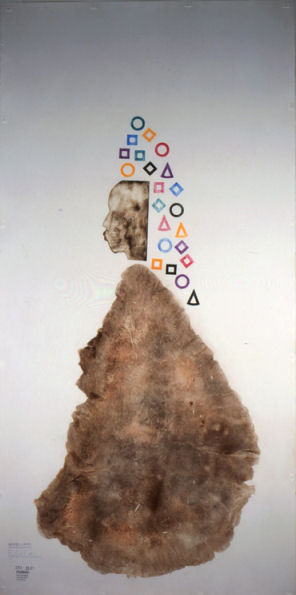 In the mean time bottles filled with banana beer were handed around. When the chief finally handed the bottle to me, I remembered the doctors warning, then took the unavoidable sip. On instructions of the chief, and in his name, my cigarettes were handed around. After having emptied several bottles of beer the rain stopped and I went outside. The evaporating water turned the surroundings grey and made everything look much smaller. Raindrops exposed themselves like treasures. Everything signalled unstoppable vitality. On the porch a medicine man had spread out his pharmacy on old flour bags. When I come near he swiftly covers everything with a piece of brown leather. I noticed some strange looking herbs and tree bark, various bones, teeth and a spotted, furry animal skin. The little paw of a dried Bat in a rolled snakeskin: the hand of a homunculus with an exotic cuff. The leather that was used as a cover against my eyes turned out to be the ear of an elephant. After an introduction by the chief I was allowed to touch it. In the mean time bottles filled with banana beer were handed around. When the chief finally handed the bottle to me, I remembered the doctors warning, then took the unavoidable sip. On instructions of the chief, and in his name, my cigarettes were handed around. After having emptied several bottles of beer the rain stopped and I went outside. The evaporating water turned the surroundings grey and made everything look much smaller. Raindrops exposed themselves like treasures. Everything signalled unstoppable vitality. On the porch a medicine man had spread out his pharmacy on old flour bags. When I come near he swiftly covers everything with a piece of brown leather. I noticed some strange looking herbs and tree bark, various bones, teeth and a spotted, furry animal skin. The little paw of a dried Bat in a rolled snakeskin: the hand of a homunculus with an exotic cuff. The leather that was used as a cover against my eyes turned out to be the ear of an elephant. After an introduction by the chief I was allowed to touch it.
Late in the afternoon (I had returned to the mission post that had granted me hospitality), I found father Davos sitting on the porch in his folding chair that was stretched with the skin of gazelle. It must have been around 5.30 p.m. The day before he told me that he reads ‘the daily paper’ before the sun goes down, at 6 p.m. His ‘daily’ newspaper is the Belgian “De Standaard”. Collected throughout the year by the missionary’s family back home and posted to him at the end of the year. They lay piled up in a corner of his bedroom. Every day he would read today’s paper from last year.
” If one lives in Congo,” he explained” it makes no difference. News is new when it reaches me. It only needs some disciplined curiosity, not to walk ahead of today, because all the news of the coming days, weeks, and months rests next to my bed. Temptation can be strong.”
After the paper is read it’s spread among locals who use it for rolling their cigarettes.
After dinner I step out into the darkness to walk around the house and study the bats that are large around here. The medicine man from that afternoon must have been waiting for me. Suddenly he’s in front of me and takes a bundle from under his arm, offers it to me. It turned out to be the elephant ear I’d looked at on the porch. Wrapped in it, a remarkable fire burned clay head , the size of a coconut. What made it special was that it lacked being African. It could have originated from all over the globe and be a Celtic Milky Way man, Inca, Christ or a Buddha I had to think of Goethe’s ‘Urpflanz’, the idea that there is only ‘one’ plant; all others are variations of that same plant. This head, I decided, was not just a head but also the ‘Ur’ head, the one present in us all. From now on, talking sculpture and head, I would use this head. The Head.
For the next day father Davos had arranged a ride for me. I could join the Canadian director of a slaughterhouse on an inspection tour near the Ruwenzori. He was so kind to treat me on a tour into the Albert wild life reserve nearby. The animals he pointed at; elephants, lions, hippos, buffalos, antelopes and so on, became the subject of his professional evaluation: “ You see that one? Good for at least 600kg first class meat.” And wile the animal turned its head: ”Look, now he’s in the right position to put him down with a single shot”
Several months’ later- somewhere in Belgium, guest in the house of a taxidermist- I stood between piles of prepared animal skins: Wildlife from Africa and elsewhere. Out of curiosity I asked if it would be possible to place an order for, let’s say a lion family and have them prepared. “In principle” the man said, ”everything is possible.” One should realise however that delivery of the hides can take up to eight weeks after I place the order by telephone.
|
|
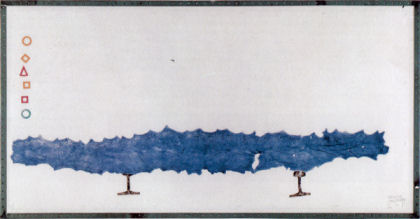
|
|
|
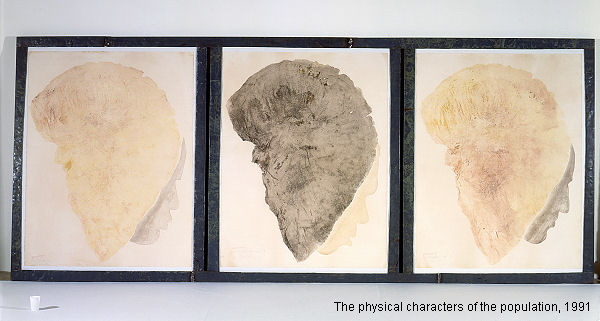
|
|
Title: The physical characters of the population, 1991
3 mono prints with river Nile sediments (Rwanda Burundi) and Elephant ears.
Frame: metal from chemical barrels.
Size: 181 x 426 cm.
Collection NOG/SNS REAAL Fonds (IN DISPUTE)
Note: The title quotes: man, animal and earth. The three different tribes that populate the Central African region of Rwanda and Burundi are depicted here in an anthropological/ environmental context. The form of the elephants ears, used as a printing stock, suggests a topological connotation, as map of the African continent itself. (From left: Bantu, Batwa (Pygmies) and Tutsi)
In 1992 the work was presented by Walter Hopps, at the exhibit Rainforest at Risk, at Fernbank Museum, Atlanta, USA.
Note by Patrick Healy on: Collection NOG/SNS REAAL Fonds (IN DISPUTE)
The designation ‘in dispute’ is not part of the running title of the work, but refers to an ongoing correspondence in which a contested claim has been placed in the public domain by the artists Virgil Grotfeldt and Waldo Bien. The correspondence has been underway since 1996. The artists have consistently drawn attention to their argument that the acquisition of their works, 28 in total, took place under misleading and false representations. When this was brought to the notice of the relevant parties they initially did not receive any disavowal or rebuttal. Only after a publication of the claim following an exhibition in Recklinghausen did they receive some staggered and ill-informed legal correspondence, which had the strategic intention to dissuade them from issuing their complaints in the future, except under the threat of an interdict. In the correspondence, the artists continued to revert to their original claims, pointed to broader ethical and moral issues, and outlined the possibility of an equitable remedy. They contested whether proper t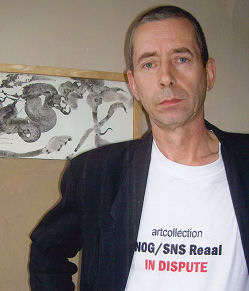 itle was held where substantial promissory undertakings, at the origin of the acquisition, with its various entailments, and in which they were bona fide agents, or could be upheld, given the persistent and flagrant breach of the promissory entailments. They invited the relevant parties and their lawyers to enter into adequate research to discover the itle was held where substantial promissory undertakings, at the origin of the acquisition, with its various entailments, and in which they were bona fide agents, or could be upheld, given the persistent and flagrant breach of the promissory entailments. They invited the relevant parties and their lawyers to enter into adequate research to discover the 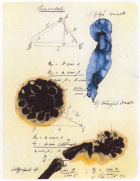 quid facti of their claim, whatever further determi- nations might be made (quid juris). To what end all the material available in the archive of the F.I.U. Amsterdam, correspondence and other material has been available to public inspection since the course of the years of the dispute, and my own research also confirms that they were not the only ones to be so wronged. quid facti of their claim, whatever further determi- nations might be made (quid juris). To what end all the material available in the archive of the F.I.U. Amsterdam, correspondence and other material has been available to public inspection since the course of the years of the dispute, and my own research also confirms that they were not the only ones to be so wronged.
|
|
|